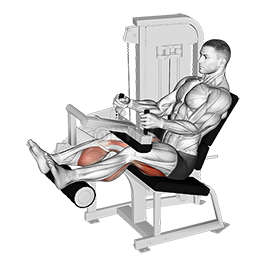
Lying Femoral
Exercise Profile
Related Exercises:
Introduction to the Lying Femoral
The Lying Femoral exercise is a lower body workout that primarily targets and strengthens the hamstrings, glutes, and lower back. It is an excellent exercise for athletes, fitness enthusiasts, and individuals looking to improve their lower body strength and flexibility. Performing this exercise regularly can enhance overall performance in sports and daily activities, promote better posture, and reduce the risk of injury.
Performing the: A Step-by-Step Tutorial Lying Femoral
- Bend your knees and place your feet flat on the floor, hip-width apart.
- Slowly lift one leg and extend it straight up towards the ceiling, keeping your other foot flat on the floor.
- With control, slowly lower your extended leg back down towards the floor without touching it.
- Repeat this motion for your desired amount of repetitions, then switch to the other leg and repeat the same steps.
Tips for Performing Lying Femoral
- Controlled Movement: When performing the Lying Femoral, it's crucial to maintain controlled movements. Avoid jerky or rapid movements which can lead to strain or injury. Raise your legs using your hamstrings until your feet are pointing to the ceiling and then slowly lower them back down.
- Full Range of Motion: Ensure you're using a full range of motion by fully extending your legs at the bottom and pulling them up as high as possible at the top. This will maximize the effectiveness of the exercise by engaging the entire muscle group.
- Avoid Overloading: It's a common mistake to use too much weight when performing this exercise. Start with a weight that allows you to
Lying Femoral FAQs
Can beginners do the Lying Femoral?
Yes, beginners can do the Lying Femoral exercise. However, it's important to start with light weights or even no weights at all, and focus on getting the form right to avoid injury. It's also crucial to warm up properly before starting the exercise. If you're unsure about how to do the exercise, it's best to ask a trainer or a fitness professional for advice.
What are common variations of the Lying Femoral?
- The Standing Leg Curl is another variation, where you stand while performing the exercise, often with the help of a machine.
- The Prone Leg Curl is a variation that involves lying flat on your stomach on a leg curl machine and curling your legs towards your buttocks.
- Another variation is the Lying Hamstring Curl with a Dumbbell, where you lie flat on a bench and hold a dumbbell between your feet while curling your legs.
- The Swiss Ball Hamstring Curl is a more challenging variation, where you lie on your back with your heels on a Swiss ball and lift your body while curling the ball towards you.
What are good complementing exercises for the Lying Femoral?
- Squats: Squats can enhance the benefits of Lying Femoral by working the same muscle groups, but in a different way, which can aid in muscle growth and improved balance.
- Deadlifts: Deadlifts are a great complementary exercise to Lying Femoral because they target the hamstrings and glutes, and also engage the lower back, improving overall lower body strength and posture.
Related keywords for Lying Femoral
- Dumbbell Lying Femoral exercise
- Hamstring workout with dumbbells
- Thigh toning exercises
- Dumbbell exercises for hamstrings
- Lying Femoral curl with dumbbells
- Strengthening thighs with dumbbells
- Hamstring and thigh dumbbell workouts
- Dumbbell Lying Femoral for leg muscles
- Dumbbell workout for strong hamstrings
- Lying Femoral exercise for toned thighs








